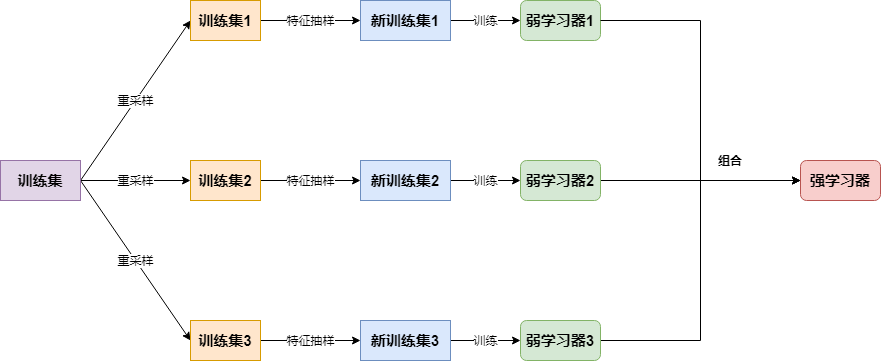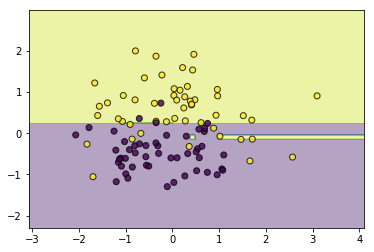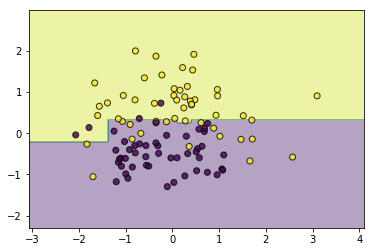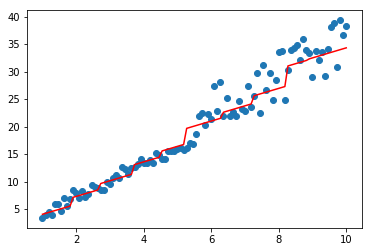《机器学习Python实现_10_08_集成学习_bagging_randomforest实现》
2021-05-06 20:39
806 查看
一.简介
为了让学习器越发的不同,randomforest的思路是在bagging的基础上再做一次特征的随机抽样,大致流程如下:

二.RandomForest:分类实现
import os
os.chdir('../')
from ml_models import utils
from ml_models.tree import CARTClassifier
import copy
import numpy as np
"""
randomforest分类实现,封装到ml_models.ensemble
"""
class RandomForestClassifier(object):
def __init__(self, base_estimator=None, n_estimators=10, feature_sample=0.66):
"""
:param base_estimator: 基学习器,允许异质;异质的情况下使用列表传入比如[estimator1,estimator2,...,estimator10],这时n_estimators会失效;
同质的情况,单个estimator会被copy成n_estimators份
:param n_estimators: 基学习器迭代数量
:param feature_sample:特征抽样率
"""
self.base_estimator = base_estimator
self.n_estimators = n_estimators
if self.base_estimator is None:
# 默认使用决策树
self.base_estimator = CARTClassifier()
# 同质分类器
if type(base_estimator) != list:
estimator = self.base_estimator
self.base_estimator = [copy.deepcopy(estimator) for _ in range(0, self.n_estimators)]
# 异质分类器
else:
self.n_estimators = len(self.base_estimator)
self.feature_sample = feature_sample
# 记录每个基学习器选择的特征
self.feature_indices = []
def fit(self, x, y):
# TODO:并行优化
n_sample, n_feature = x.shape
for estimator in self.base_estimator:
# 重采样训练集
indices = np.random.choice(n_sample, n_sample, replace=True)
x_bootstrap = x[indices]
y_bootstrap = y[indices]
# 对特征抽样
feature_indices = np.random.choice(n_feature, int(n_feature * self.feature_sample), replace=False)
self.feature_indices.append(feature_indices)
x_bootstrap = x_
56c
bootstrap[:, feature_indices]
estimator.fit(x_bootstrap, y_bootstrap)
def predict_proba(self, x):
# TODO:并行优化
probas = []
for index, estimator in enumerate(self.base_estimator):
probas.append(estimator.predict_proba(x[:, self.feature_indices[index]]))
return np.mean(probas, axis=0)
def predict(self, x):
return np.argmax(self.predict_proba(x), axis=1)
#造伪数据 from sklearn.datasets import make_classification data, target = make_classification(n_samples=100, n_features=2, n_classes=2, n_informative=1, n_redundant=0, n_repeated=0, n_clusters_per_class=1, class_sep=.5,random_state=21)
#同质 classifier = RandomForestClassifier(feature_sample=0.6) classifier.fit(data, target) utils.plot_decision_function(data, target, classifier)

#异质 from ml_models.linear_model import LogisticRegression from ml_models.svm import SVC classifier = RandomForestClassifier(base_estimator=[LogisticRegression(),SVC(kernel='rbf',C=5.0),CARTClassifier(max_depth=2)],feature_sample=0.6) classifier.fi 56c t(data, target) utils.plot_decision_function(data, target, classifier)

三.代码实现:回归
from ml_models.tree import CARTRegressor """ random forest回归实现,封装到ml_models.ensemble """ class RandomForestRegressor(object): def __init__(self, base_estimator=None, n_estimators=10, feature_sample=0.66): """ :param base_estimator: 基学习器,允许异质;异质的情况下使用列表传入比如[estimator1,estimator2,...,estimator10],这时n_estimators会失效; 同质的情况,单个estimator会被copy成n_estimators份 :param n_estimators: 基学习器迭代数量 :param feature_sample:特征抽样率 """ self.base_estimator = base_estimator self.n_estimators = n_estimators if self.base_estimator is None: # 默认使用决策树 self.base_estimator = CARTRegressor() # 同质 if type(base_estimator) != list: estimator = self.base_estimator self.base_estimator = [copy.deepcopy(estimator) for _ in range(0, self.n_estimators)] # 异质 else: 56c self.n_estimators = len(self.base_estimator) self.feature_sample = feature_sample # 记录每个基学习器选择的特征 self.feature_indices = [] def fit(self, x, y): # TODO:并行优化 n_sample, n_feature = x.shape for estimator in self.base_estimator: # 重采样训练集 indices = np.random.choice(n_sample, n_sample, replace=True) x_bootstrap = x[indices] y_bootstrap = y[indices] # 对特征抽样 feature_indices = np.random.choice(n_feature, int(n_feature * self.feature_sample), replace=False) self.feature_indices.append(feature_indices) x_bootstrap = x_bootstrap[:, feature_indices] estimator.fit(x_bootstrap, y_bootstrap) def predict(self, x): # TODO:并行优化 preds = [] for index, estimator in enumerate(self.base_estimator): preds.append(estimator.predict(x[:, self.feature_indices[index]])) return np.mean(preds, axis=0)
#构造数据 data = np.linspace(1, 10, num=100) target1 = 3*data[:50] + np.random.random(size=50)*3#添加噪声 target2 = 3*data[50:] + np.random.random(size=50)*10#添加噪声 target=np.concatenate([target1,target2]) data = data.reshape((-1, 1))
#同质 import matplotlib.pyplot as plt model=RandomForestRegressor(base_estimator=CARTRegressor(),n_estimators=2,feature_sample=1)#feature就一列,没办法... model.fit(data,target) plt.scatter(data, target) plt.plot(data, model.predict(data), color='r')
[<matplotlib.lines.Line2D at 0x18f3f5866d8>]

#异质 from ml_models.linear_model import LinearRegression model=RandomForestRegressor(base_estimator=[LinearRegression(),CARTRegressor()],feature_sample=1) model.fit(data,target) plt.scatter(data, target) plt.plot(data, model.predict(data), color='r')
[<matplotlib.lines.Line2D at 0x18f2d6dd160>]

相关文章推荐
- 【机器学习入门二】集成学习及AdaBoost算法的python实现
- 集成学习AdaBoost算法原理及python实现
- Python机器学习:通过scikit-learn实现集成算法
- 机器学习基础篇--监督学习经典案例(Python实现)
- Python机器学习:通过scikit-learn实现集成算法
- python机器学习第八章:集成学习——组合不同模型(自然语言处理)
- 小白学习机器学习---第三章:简单线性模型Python实现
- 机器学习实战(10) ——K均值聚类算法(python实现)
- 【Python成长之路】机器学习:10+分类算法汇总学习
- 学习笔记(10):程序员的数学:优化理论-Python实现共轭梯度法-02
- 集成学习自动权重设置python实现
- 西瓜书 第八章习题 集成学习总结(Adaboost、GradientBoost、Bagging、RandomForest)
- 基于 Python 的数据结构与算法分析学习记录(6-10)—— 二叉堆实现
- 机器学习学习笔记——logistic回归(数学推导及python实现)
- 小白学习机器学习---第五章:神经网络简单模型python实现
- win10+Python3.7.3+OpenCV3.4.1入门学习(十四 傅里叶变换)————14.3 OpenCV实现傅里叶变换
- 小白学习机器学习---第三章(3):二分类LDA的python实现
- 机器学习知识点(十六)集成学习AdaBoost算法Java实现
- TensorFlow学习——CIFAR-10(python实现数据可视化)
- 学习笔记(08):第三章:集成机器学习-XGBoost原理
